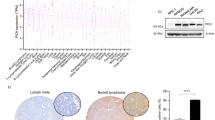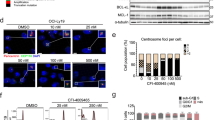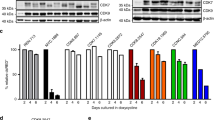Abstract
Chk1 plays a crucial role in the DNA damage and replication checkpoints in vertebrates and may therefore be an important determinant of tumour cell responses to genotoxic anticancer drugs. To evaluate this concept we compared the effects of the nucleoside analogue 5-fluorouracil (5FU) on cell cycle progression and clonogenic survival in DT40 B-lymphoma cells with an isogenic mutant derivative in which Chk1 function was ablated by gene targeting. We show that 5FU activates Chk1 in wild-type DT40 cells and that 5FU-treated cells accumulate in the S phase of the cell cycle due to slowing of the overall rate of DNA replication. In marked contrast, Chk1-deficient DT40 cells fail to slow DNA replication upon initial exposure to 5FU, despite equivalent inhibition of the target enzyme thymidylate synthase, and instead accumulate progressively in the G1 phase of the following cell cycle. This G1 accumulation cannot be reversed rapidly by exogenous thymidine or removal of 5FU, and is associated with increased incorporation of 5FU into genomic DNA and severely diminished clonogenic survival. Taken together, these results demonstrate that a Chk1-dependent replication checkpoint which slows S phase progression can protect tumour cells against the cytotoxic effects of 5FU.
This is a preview of subscription content, access via your institution
Access options
Subscribe to this journal
Receive 50 print issues and online access
$259.00 per year
only $5.18 per issue
Buy this article
- Purchase on Springer Link
- Instant access to full article PDF
Prices may be subject to local taxes which are calculated during checkout








Similar content being viewed by others
References
Abraham RT . (2001). Genes Dev 15: 2177–2196.
Bartek J, Lukas J . (2003). Cancer Cell 3: 421–429.
Feijoo C, Hall-Jackson C, Wu R, Jenkins D, Leitch J, Gilbert DM et al. (2001). J Cell Biol 154: 913–923.
Glazer RI, Lloyd LS . (1982). Mol Pharmacol 21: 468–473.
Graves PR, Yu L, Schwarz JK, Gales J, Sausville EA, O'Connor PM et al. (2000). J Biol Chem 275: 5600–5605.
Heidelberger C, Danenberg PV, Moran RG . (1983). Adv Enzymol Relat Areas Mol Biol 54: 58–119.
Ingraham HA, Dickey L, Goulian M . (1986). Biochemistry 25: 3225–3230.
Ingraham HA, Tseng BY, Goulian M . (1980). Cancer Res 40: 998–1001.
Kastan MB, Bartek J . (2004). Nature 432: 316–323.
Kufe DW, Major PP . (1981). J Biol Chem 256: 9802–9805.
Liu X, Guo Y, Li Y, Jiang Y, Chubb S, Azuma A et al (2005). Cancer Res 65: 6874–6881.
Longley DB, Harkin DP, Johnston PG . (2003). Nat Rev Cancer 3: 330–338.
Mauro DJ, De Riel JK, Tallarida RJ, Sirover MA . (1993). Mol Pharmacol 43: 854–857.
Meyers M, Wagner MW, Hwang HS, Kinsella TJ, Boothman DA . (2001). Cancer Res 61: 5193–5201.
Meyers M, Wagner MW, Mazurek A, Schmutte C, Fishel R, Boothman DA . (2005). J Biol Chem 280: 5516–5526.
Morgan MA, Parsels LA, Parsels JD, Mesiwala AK, Maybaum J, Lawrence TS . (2005). Cancer Res 65: 6835–6842.
Nyberg KA, Michelson RJ, Putnam CW, Weinert TA . (2002). Annu Rev Genet 36: 617–656.
Rhind N, Russell P . (2000). J Cell Sci 113 (Part 22): 3889–3896.
Sampath D, Rao VA, Plunkett W . (2003). Oncogene 22: 9063–9074.
Santi DV, McHenry CS, Sommer H . (1974). Biochemistry 13: 471–481.
Shi Z, Azuma A, Sampath D, Li YX, Huang P, Plunkett W . (2001). Cancer Res 61: 1065–1072.
Tajima A, Hess MT, Cabrera BL, Kolodner RD, Carethers JM . (2004). Gastroenterology 127: 1678–1684.
Xiao Z, Xue J, Sowin TJ, Rosenberg SH, Zhang H . (2005). Oncogene 24: 1403–1411.
Zachos G, Rainey MD, Gillespie DA . (2003). EMBO J 22: 713–723.
Zachos G, Rainey MD, Gillespie DA . (2005). Mol Cell Biol 25: 563–574.
Zhao H, Piwnica-Worms H . (2001). Mol Cell Biol 21: 4129–4139.
Zou L, Elledge SJ . (2003). Science 300: 1542–1548.
Acknowledgements
We thank Dr Kevin Ryan for insightful comments on the manuscript. This work was supported by Cancer Research UK (CR-UK) and the Association for International Cancer Research (AICR).
Author information
Authors and Affiliations
Corresponding author
Rights and permissions
About this article
Cite this article
Robinson, H., Jones, R., Walker, M. et al. Chk1-dependent slowing of S-phase progression protects DT40 B-lymphoma cells against killing by the nucleoside analogue 5-fluorouracil. Oncogene 25, 5359–5369 (2006). https://doi.org/10.1038/sj.onc.1209532
Received:
Revised:
Accepted:
Published:
Issue Date:
DOI: https://doi.org/10.1038/sj.onc.1209532
Keywords
This article is cited by
-
ATF2 loss promotes 5-FU resistance in colon cancer cells via activation of the ATR-Chk1 damage response pathway
BMC Cancer (2023)
-
AKT overactivation can suppress DNA repair via p70S6 kinase-dependent downregulation of MRE11
Oncogene (2018)
-
ATR mediates cisplatin resistance in a p53 genotype-specific manner
Oncogene (2011)
-
Pharmacological activation of a novel p53-dependent S-phase checkpoint involving CHK-1
Cell Death & Disease (2011)
-
Chk1 deficiency in the mouse small intestine results in p53-independent crypt death and subsequent intestinal compensation
Oncogene (2009)



